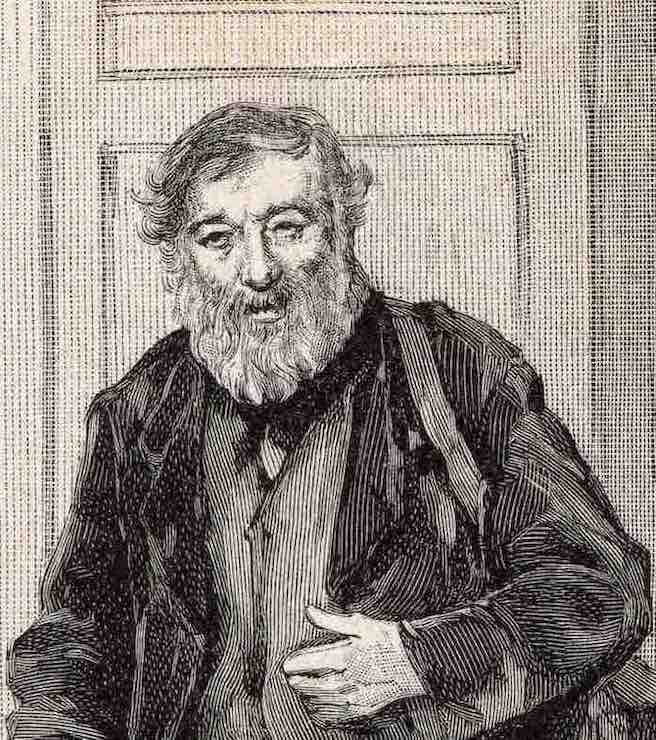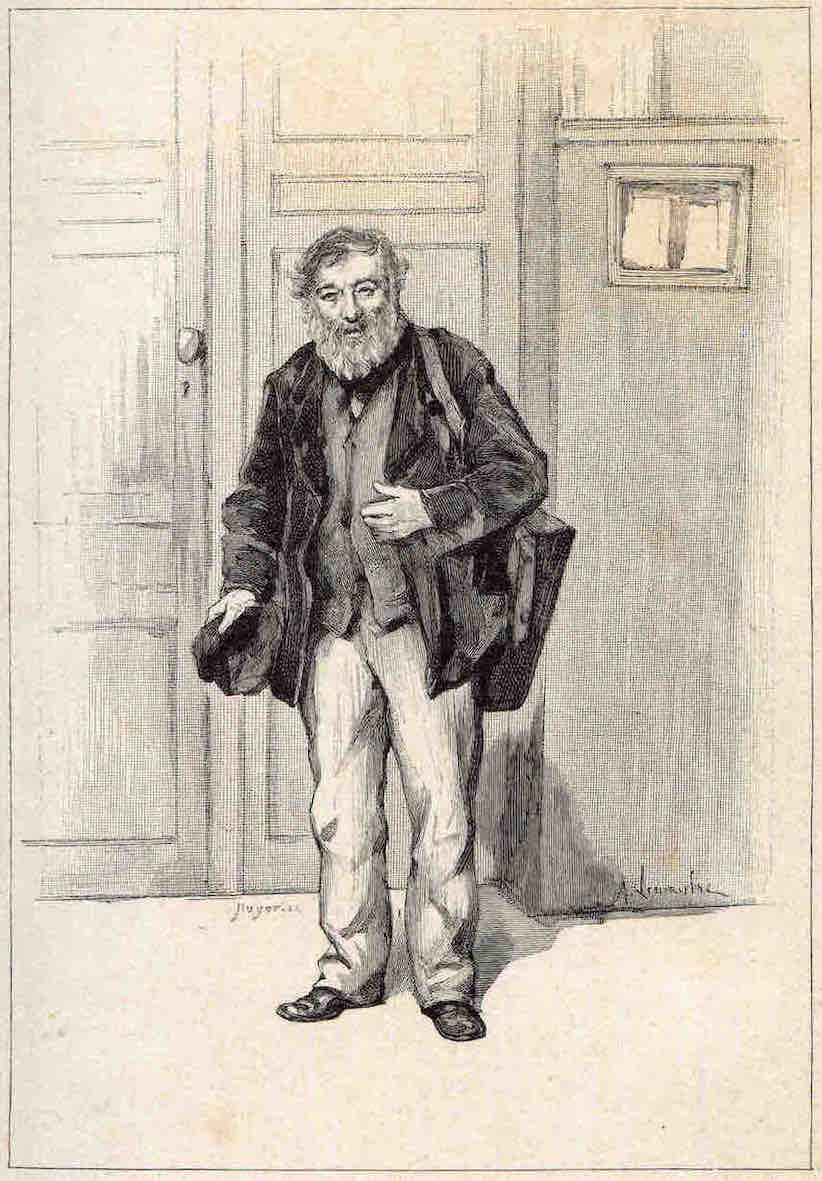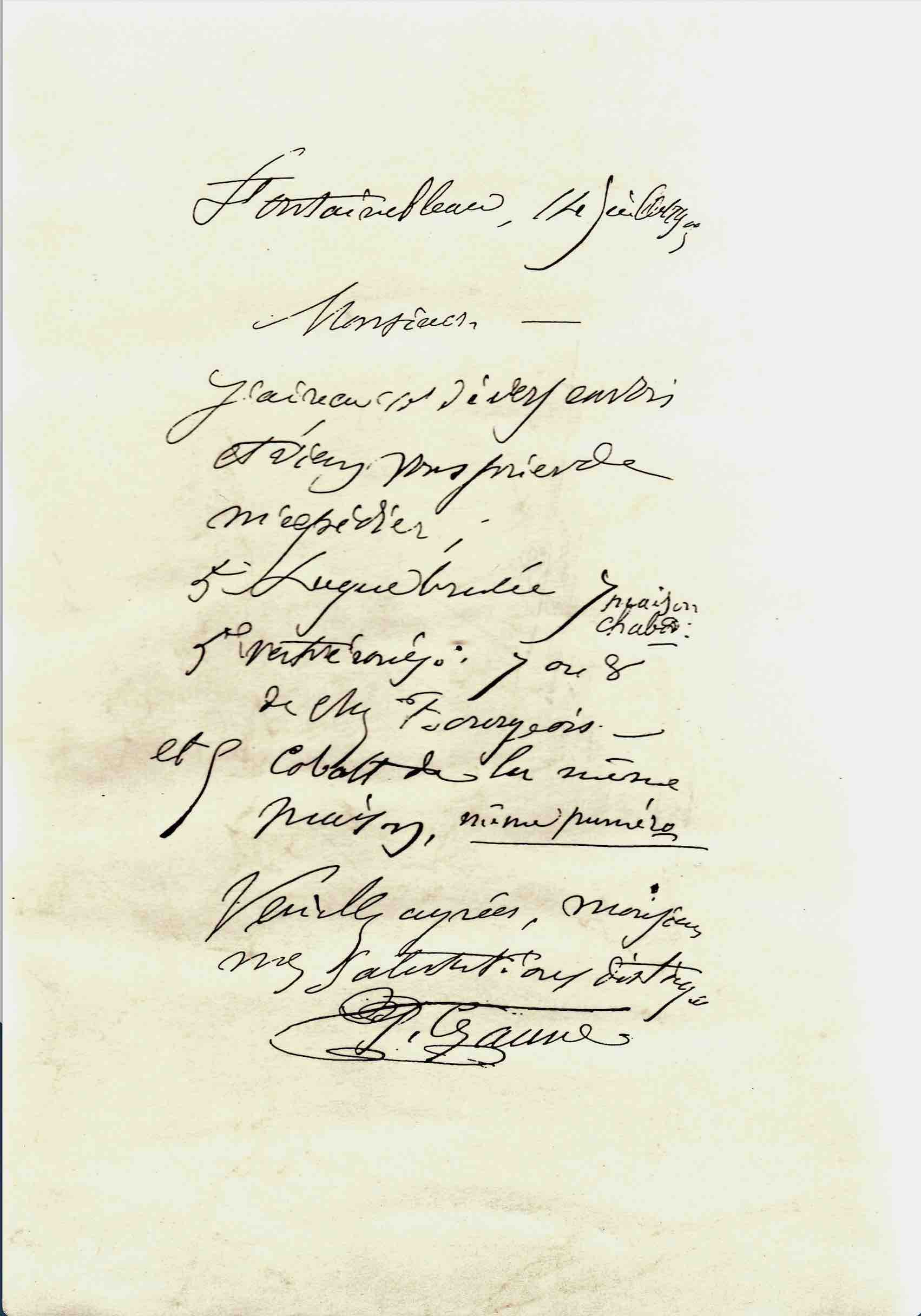
one of Cézanne’s suppliers : Chabod



New information on one of Cézanne’s suppliers
Dear subscribers, dear visitors,
I wish you all an excellent return to work after a refreshing summer break.
As we pursue our task of constantly adding to the Guide, we nonetheless cannot resist the pleasure of sharing some recent discoveries concerning the firm of Chabod. The name of this merchant is well known to specialists and to those familiar with Cézanne, as the artist occasionally bought supplies from him and rated a number of his paints extremely highly.
The face and general appearance of this supplier, known as “Père Chabod”—just as there was a “Père Tanguy” (another of Cézanne’s dealers)—has long been known from a sketch by a student at the École des Beaux-Arts in Paris, Alexis Lemaistre. Lemaistre also left a delightful account of Père Chabod’s going round the School studios to furnish students with tubes of paint, canvases, etc. (qv. document below).
Recently we unearthed considerably more about Chabod’s background, marital status and life story.
Jean Michel Chabod (1829-1892) was an Italian immigrant from the Aosta Valley, like many Parisian colormen in the 19th and 20th centuries (we have already mentioned this in other articles and will return to it at greater length).
Born on October 4, 1819, in Courmayeur (Italy), he was the son of Jean Antoine Chabod and Catherine Belfrond. Though we do not know when he arrived in Paris, Chabod was already established in the capital at the age of twenty-eight, as indicated on the certificate of his first marriage. In January 1848, Chabod, then residing at 20, rue Montmartre and working as a color grinder, wedded Catherine Bailly, a seamstress specializing in waistcoats, then domiciled at the same address. By 1855, Chabod also owned a framing business, renting premises at 15, rue de Buci (current number 13). From 1855 to 1877 the lease for this third floor workshop on the courtyard remained in his name. Chabod was therefore the neighbor of the paint dealer Bovard, who had a store on the first floor of the same building at 15, rue de Buci. Moreover, when Bovard ceased trading in 1863, Chabod took over the business. The onetime grinder and framer thus became an artists’ colorman (marchand de couleurs fines), the profession he declared at the time of his second marriage in 1872.
After the death of Catherine Bailly, the widower married a young girl from Alsace (Offenheim, in the Bas-Rhin), also a waistcoat tailor like her predecessor. Marie Anne Blaes by name, his second wife was twenty-seven at the time, while Chabod was in his fifty-third year. For some time the store remained on rue du Buci, but then, in 1877, it moved to 20, rue Jacob, a little closer to the École des Beaux-Arts some 200 meters away. As attested by a number of written documents (see below), as well as by marks on the back of canvases used during prize competitions, students at the School would make frequent recourse to Chabod’s supplies.
Chabod ran the business until his death in September 1892. It was then continued by his widow Marie Anne Chabod, née Baes, under various trading names (Maison Chabod, Veuve Chabod, Veuve M. Chabod), before being taken over by Nicolas Abel Vignol in 1906 or shortly before. The canvas and paint business went bankrupt in 1913, but Vignol kept on the premises at 20, rue Jacob, employing it for a painting gallery until at least 1935.
For more details see the pages devoted to the house of Paul Cézanne and his suppliers, and to the Maison Bovard, Chabod, Vignol in the Labreuche Guide, https://www.guide-labreuche.com
Documents
1. An unpublished letter by Paul Cézanne
An unpublished letter by Paul Cézanne, a facsimile of which appears in the Lefranc Bourgeois Paris archives (reproduced opposite), demonstrates the artist’s loyalty to the firm of Chabod and his predilection for a number of its paints. Cézanne ordered five tubes of laque brûlée number 7 (bunt lake or madder brown?) from Chabod while staying in Fontainebleau in July 1905. Shortly before his death, Cézanne was still buying from the same firm, as shown by a letter to his son of September 1906 mentioning paints returned to Vignol (1).
Fontainebleau, July 14, 1905
Sir, —
I have received your various shipments
and would request you to
to send me:
5 Laque brulée 7 from Maison
Chabod
5 Veronese green 7 or 8
from Bourgeois
and 5 cobalt from the same
firm, same number
Yours most faithfully,
P. Cezanne
(1) Elisabeth Reissner, “Ways of Making: Practice and Innovation in Cézanne’s Painting in the National Gallery,” National Gallery Technical Bulletin, vol. 29, 2008, p. 4–30.
2. Alexis Lemaistre’s account
"THE PAINT SUPPLIER. After the models, the only people allowed to enter the studios during sessions are paint suppliers and dealers in photographs, art documents, etc. — The latter are also to be found in architecture studios. Among paint dealers, first place goes to Père Chabod, their doyen and the students’ favorite. Not that he sells his tubes of cobalt or fine lake more cheaply than the others; but he is a bon vivant, he knows how to laugh at jokes, and he accepts with all the grace in the world the fanciful epithets with which his name is sometimes embellished; moreover, his paints are good; and then, — and herein lies the secret of his popularity, — he offers generous credit to any student at the School. He comes regularly every Monday, and then, once or twice a week, he comes to see if any of his friends, the painters, need anything. To save them any trouble, he makes sure of this in person, peering into the open paint-boxes on their stands. “I say! Haven’t you got any more peach-stone black?... And, you, no more red-brown?... Ah! if I hadn’t come you wouldn’t have had enough yellow ocher to finish your figure...” In short, Père Chabod is an incarnation of Providence. A strange incarnation, to be sure! Stocky, solidly built, with mischievous little eyes in a broad, open face framed by a thick grey beard, he is a joy to watch as he goes round with a large box of paints on his back and a pack of canvases under each arm, guffawing at the the students’ jokes and puns. Sometimes a competitor will come in to hawk his wares. “No need for paint, gentlemen?” But try as he might to lay out his tubes, nobody so much as looks at him; and, if anyone hears that Père Chabod’s in the workshop next door, everybody starts shouting: “Hey, Chabod!” The shouts last until Chabod, elated, triumphant, makes his entrance... Upon which, the competitor packs his bags and slinks off."
Alexis Lemaistre, L’École des Beaux-Arts dessinée et racontée par un élève, Paris: Librairie Firmin-Didot et Cie, 1889, pp. 43–44.